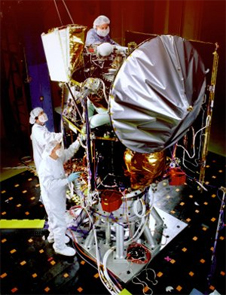September 29, 2009 Vol. 2, Issue 9
On September 23, 1999, a measurement discrepancy placed the Mars Climate Observer too close to the Martian surface, causing it to go silent.

Acoustics testing simulating launch conditions being performed on the Mars Climate Orbiter as it enters the final stages of testing prior to launch in December of 1998. Photo credit NASA
The Mars Climate Observer (MCO), the first interplanetary weather satellite, was also designed to serve as a communication relay for the Mars Polar Lander (MPL) trailing behind it. The observer and lander were intended to map the planet’s surface, profile the structure of the atmosphere, detect surface ice reservoirs and dig for traces of water beneath the surface.
After a nine and a half month journey to Mars, MCO fired its main engines to insert itself into an elliptical orbit around the planet. Due to a Martian eclipse, ground controllers anticipated a 21-minute loss of contact with the orbiter. When the eclipse was over, however, ground control never regained contact.
Originally, MCO was to execute an initial engine thrust and enter into elliptical orbit around Mars with an altitude no lower than 210km. However, after the orbiter went silent, the navigation crew calculated orbiter’s altitude to be around 110km. Engineers spent the next six days crunching numbers and finally determined that MCO was actually 57km above the ground after the initial engine thrust. The minimum survivable altitude was 80km.
The root cause of the error was units — metric versus English. MCO was designed using metric units. However, the Mars Climate Observer Mishap Investigation Board found that the “Small Forces” software file was coded to send output data in English units. The spacecraft was sending telemetry data (in metric) and a trajectory estimate (in metric) back to Earth, both of which were relayed through the English-based Small Forces file.
Had the spacecraft been at the appropriate altitude, it would have gone through an aerobraking phase for a few weeks, skimming through the Martian atmosphere to slow down and achieve the circular orbit. Mars Polar Lander was then scheduled to touch down on Mars on December 3, 1999 and begin sending data to MCO. Mars Polar Lander was also lost due to a communication problem.
Several investigations and reports followed the twin Mars failures. NASA’s MCO Mishap Investigation Board issued a report entitled “Project Management at NASA.” Tony Spear, the retired project manager of Mars Pathfinder, led a “Faster, Better, Cheaper” task force to understand the management context at NASA at the time. A board headed by Tom Young, a veteran of NASA’s Viking missions who went on to serve as CEO of Lockheed Martin, led a Mars Program Independent Assessment.
Watch a video of Tom Young talking about lessons learned from the Mars failures.





